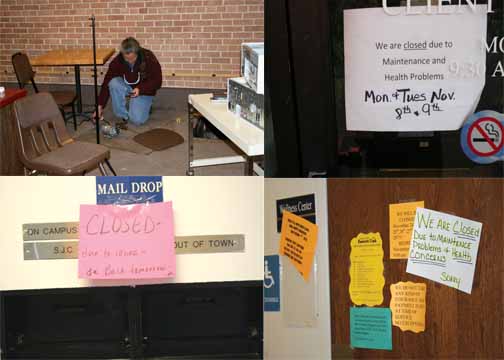Stench in SAC solved
After three weeks of headaches, sinus problems and nose bleeds, residents in the SAC may feel better without their daily dose of pain killers and tissue paper. Utah State University’s Rachel Curry, safety/industrial hygienist, was on campus Thursday, Nov. 11 to test the air quality in the building and provide a plan to aerate the building of the sewer gasses that have plagued its residences.

After three weeks of headaches, sinus problems and nose bleeds, residents in the SAC may feel better without their daily dose of pain killers and tissue paper. Utah State University’s Rachel Curry, safety/industrial hygienist, was on campus Thursday, Nov. 11 to test the air quality in the building and provide a plan to aerate the building of the sewer gasses that have plagued its residences.
Besides the smell, she was concerned with the standing water in the crawl space and the steam pipes creating hot air to enhance the already rancid smell. The hole in the sewer pipe was fixed a week after the smell sickened the residents of the building. After touring the building and taking samples earlier in the day, Curry quipped that she really did not want to come back into the building later that night to take additional samples because of the smell.
In e-mail Curry wrote, “Please note that although the levels of hydrogen sulfide measured did not constitute an immediate danger to the building occupants, the heat, humidity and odor entering the building from the crawl space below were certainly problematic. Complaints about headaches, nausea, and a general sick feeling are not surprising given the conditions at the time.
“Hydrogen sulfide is a component of sewer gas and is used as an identifier of potential sewer related issues. The odor threshold for hydrogen sulfide is 0.0005 parts per million (ppm). This means that hydrogen sulfide can be detected by the nose at extremely low concentrations. The OSHA Permissible-Exposure Limit (PEL) is 10 ppm with a Short-Term Exposure Limit (STEL) of 15 ppm and a ceiling limit of 20 ppm.
“When investigating indoor air quality concerns, a multi-gas meter is often employed. The meter I used was a five-gas meter capable of detecting oxygen level, carbon monoxide (CO), volatile organic compounds (VOCs), hydrogen sulfide (H2S), and lower explosive limit (LEL). The meter can detect hydrogen sulfide in the range of 0-100 ppm, with a resolution of 1 ppm. During my visit . . . no hydrogen sulfide was detected leading to the conclusion that levels were between the odor threshold and 1 ppm.”
Earlier in the week, a meter measured the H2S levels at .13 and the oxygen at 17. Normal air quality should be between 19.5 and 21.5.
It was a long three weeks for the SAC residents with part-time employees sent home in the counseling center and the cosmetology, health and wellness center and post office closing because of the health issues after breathing the sewer smell.
Most everyone in the building experienced headaches with some having migraine symptoms. Three faculty and staff experienced nosebleeds as well as numerous cosmetology students. Some had upper respiratory problems that had to be treated by medical personnel.
CEU student Rachel Smith had nosebleeds, crackling in her nose, dizziness, light headiness, upset stomach, watery eyes and pressure in her head, ears and face.
Shaklee Pecs experienced pounding headaches, stinging eyes and became nauseous. Tarnish Robertson was sick to her stomach and had headaches.
Marci Hunt started with a headache each day and then became nauseated. Kristen Kilo said she had terrible headaches, blurred vision and lack of concentration. Mattie Reynolds got sick to her stomach and had bad headaches. Her eyes watered when she entered the building and had pressure in her nose and head. She felt nauseous even after she went home. Kylee Ann Woodward had burning in her throat, slight headache and stomach pain. Laura Mitchell had migraines. Tricia Oiler had headaches, was sick to her stomach and had dizziness. Lacey Faial admitted to being a person is never sick. She said she had extremely bad headaches, nausea and sinus pressure.
Few people who worked or attended classes in the building did not complain of health problems.
After seven days of health problems, the first comment from the CEU Director of Facilities, Sheila Burkhart, was in e-mail, writing that the smell was from an “a slight drip coming from the restroom in the north hall.” However after it was determined it was a sewer spill, a chemical engineer was called in and water samples taken on Nov. 5 and 8. Brad King, vice chancellor of administration and advancement, e-mailed residents of the building, “As short term actions, the spill area has been treated with a bleach solution. After the sample was taken, another treatment was applied with the product that was successful in treating the odor in the Student Center. An additional ventilation fan was installed in the crawl space yesterday. When the analysis comes back, it will give us additional steps to take to treat the odor. This may include a more specific microorganism that attacks the source of odors. I have asked Sheila to get with DFCM and request that they do another air quality test as they did in 2007, to insure that there are no toxins in the air, that did not show up in the ground water analysis.”
On Nov. 4, he e-mailed another update, “Yesterday morning a new sump pump was installed and began working. It will run any time there is moisture. This has replaced an older, less efficient pump and should make a big difference. Also this afternoon we are expecting an OZONE generator to arrive and begin to operate. This must be done while people are out of the building so this will be started at 11 p.m. and operate through the night and this weekend. It is billed to not only eliminate odor and replace it with good air, but to kill bacteria and eliminate particles and dust and all manner of other bad stuff. It is commercial in nature and what is used in motels and by disaster crews. We hope that this will finish doing the trick. Please minimize your need to be in the building late or on this weekend and let us see if it will be the solution.”
On Nov. 11, he wrote, “Today we had a visit from Rachel Curry of Use’s indoor air quality department. She did tests and found similar results to the previous testing which indicated readings of less that one part per million. The current guidelines are less than five parts per million is not considered dangerous. We are sending more water samples from other parts of the crawl space to identify any other areas of concern and the plumber will be doing a crawl through tomorrow to see if there are additional areas that might be leaking. Our HVAC contractor has been asked to look for a way to render the crawl space to a negative air pressure and to vent it outside so that the air will not be coming up through the floor above the crawl space.
“DFCM is coming next week to do an update on our structural condition report for the building which we will use to support a request for some emergency funds to help mitigate the smell problem. The increased smell this afternoon was caused by the plumber and the testing of the crawl space which required that they open the crawl space.”
On Nov. 15, he wrote, “Over the weekend fans were installed in the crawl space and vented to the exterior of the building. The crawl through was completed by the plumber (no additional leaks were found). The latest water sample has been collected and sent to the lab. Doorstops have been placed by outside doors.
“The fans seem to have created the desired effect. With the negative air pressure in the crawl space, the fumes should no longer rise to the ground floor. The steam pipes have been fixed and no steam is stirring up things in the crawl space.”
This is week four and most of the toxic smell is dissipated. However, an overwhelming smell of “air freshener” is filling the hallways. Some people still are getting headaches and the light headiness, but nowhere near what they experienced three weeks ago.




